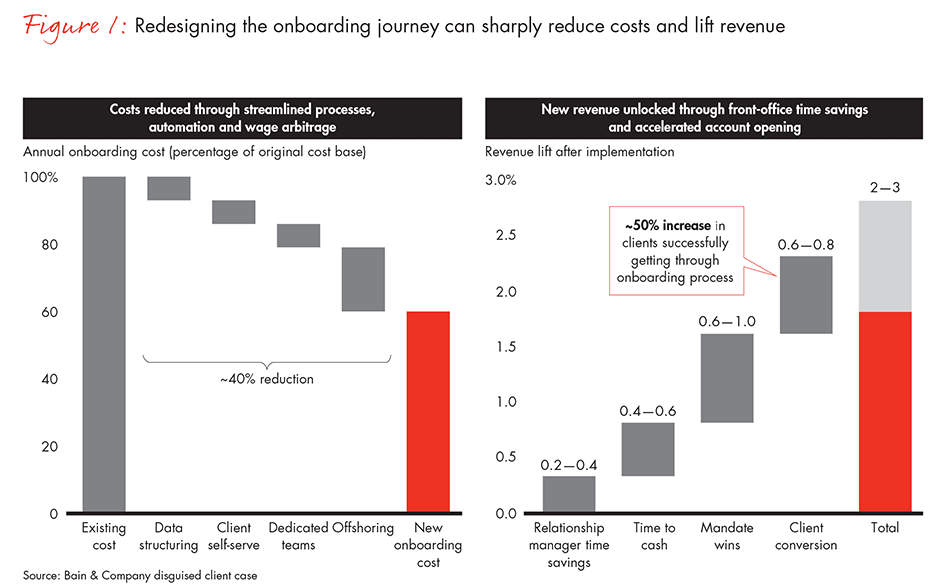Brief

Drug dealers and terrorists need to launder their money—and that’s a problem for commercial banks. Stricter regulations and enforcements have targeted institutions that do business (knowingly or not) with such customers. Major banks worldwide have incurred almost $200 billion in fines since 2009, damaging their reputations in the process.
In response to this new regulatory environment, banks have had to overhaul their onboarding and know-your-customer (KYC) processes. Some banks have relied on adding more staff to solve the problem, but often they do so without an organized plan. That has added complexity, and we estimate that costs have risen sharply to between $500 and $5,000 per client, depending on the client size and the bank location. To make matters worse, delays in acquiring customers, with the time to cash ranging from 20 days to 90 days, cause a substantial amount of lost revenue, sometimes more than $25,000 per client, according to Bain & Company’s benchmarking of major banks.
Several problems pervade banks’ processes for onboarding commercial customers. Our interviews with corporate customers reveal widespread frustration with banks’ unclear requirements, limited use of existing data, piecemeal requests for documentation and weeks-long delays for access after an account has been requested. Their frustration, combined with complex, duplicative and seemingly bureaucratic processes, wears down front-line employees as well. Half to three-quarters of onboarding requests never reach the final stage of account opening, the benchmarking found, which wastes time and effort and causes occasional embarrassment with customers.
Reducing the complexity and resource intensity of the process clearly presents a significant profit opportunity. How can banks streamline onboarding without compromising their risk management? To some extent, onboarding can increasingly be handled by external KYC vendors such as Clarient Entity Hub and kyc.com. These vendors use highly standardized data structures, split costs among many institutions and profile a single customer once on behalf of all banks. However, outsourcing is not a panacea, and most banks have to keep onboarding fully or partially internal if, for instance, they face specific regulatory requirements.
Fortunately, there are proven steps to success in onboarding. Our experience with leading major banks has yielded the following five initiatives for substantial onboarding improvements.
Identify what data the organization truly needs to ensure compliance. Onboarding requirements and forms tend to swell over time with regulatory changes and local variations, yet obsolete material does not get culled. Rationalizing the documents to a coherent list of essential data points will help to minimize complexity and reduce the workload.
Align globally. Rather than treating onboarding as a local activity, it makes sense for multinational banks and those offering a broad product range to take the approach of a global core plus any necessary local or product variations. Create a single, global set of questions that will capture all required information. If needed, add forms for other specific country or product information. A global master eliminates the need to fill out duplicate information when existing customers apply for new products or in new countries. A global bank can go from more than 1,000 onboarding-related forms to just a handful, improving the customer experience and team productivity and reducing compliance risks.
Enable self-service through an intuitive digital portal. Customers appreciate a self-serve portal with a clear layout that leads the user through the process in a structured, intuitive path. The portal can be enhanced with features such as advanced character recognition so that proof of address serves to pre-populate fields. And it should be integrated with other IT systems to allow for the automatic population and maintenance of data. Eliminating manual keying of data and delegating certain tasks to customers should reduce the number of required employees and improve data quality.
Dedicate specialist teams. Segregate staff tasks along client-facing and non-client-facing lines. Each dedicated team should use global procedures and governance structures so that the process keeps pace with changing requirements. Having dedicated teams increases productivity and lowers operating costs. It also raises the level of professionalism and reduces the susceptibility to fraud, with approval tasks carried out by back-office staff who are isolated from the risk of client coercion.
Create global centers of excellence. The case for clustering onboarding staff in a few global sites that are chosen to suit language and time zone requirements rests on consistency and efficiency. Having a few centers using the same process, rather than staff scattered throughout the world or colocated but using different processes for different segments or products, ensures a more consistent approach. Pooled volumes allow for smaller team sizes because of greater efficiency. Offshoring enables wage arbitrage in order to reduce costs. Global centers also reduce compliance risk, through stronger governance and the ability to quickly roll out process changes.
By investing in these five areas, commercial banks can realize several benefits. Faster approvals and convenient digital interactions can greatly improve the customer experience. Simplifying and automating processes, combined with wage arbitrage, can reduce the cost base by as much as 40%. Time savings and accelerated account opening (plus more time for the front office to spend on business development) with a greater win rate can unlock incremental revenue of 3% to 10% in the first year for new clients, which is often worth 2% to 3% of total banking revenue (see Figure 1). Onboarding thus merits investment to make commercial customers’ lives easier and improve a bank’s economics.

